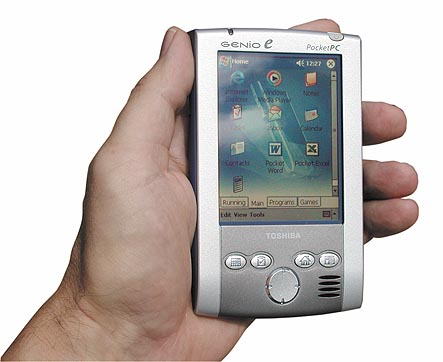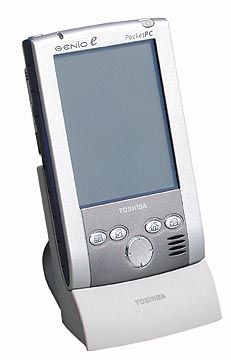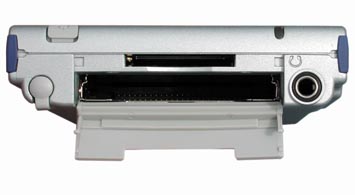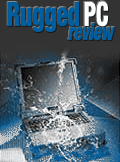October 4, 2001 --
After what to Microsoft must have been a disheartening exodus of major players
from the Windows CE camp over the past three years, things are starting to look a
whole lot better. The Pocket PC platform is going gangbuster, making serious
inroads on the previously invulnerable Palm for perhaps the first time. Compaq,
Casio, and Hewlett Packard are all introducing exciting new hardware. And now
Toshiba is joining the Pocket PC party with the brand-new Toshiba Pocket PC e570.
 Toshiba, of course, is a world leader in high technology products with somewhere
around US$54 billion in annual sales. For Toshiba to join the Pocket PC team is a
major coup for Microsoft. It is also exceedingly good news for potential PDA
customers everywhere as they now have a larger selection of high innovative
quality products to choose from. So even though the e570 is Toshiba's first
Pocket PC product, expectations are high. Does the Genio deliver? Let's take a
look at Toshiba's new device.
Toshiba, of course, is a world leader in high technology products with somewhere
around US$54 billion in annual sales. For Toshiba to join the Pocket PC team is a
major coup for Microsoft. It is also exceedingly good news for potential PDA
customers everywhere as they now have a larger selection of high innovative
quality products to choose from. So even though the e570 is Toshiba's first
Pocket PC product, expectations are high. Does the Genio deliver? Let's take a
look at Toshiba's new device.
 First impressions is that the Genio is a smartly styled device that pretty much
follows the current conventions in PDA design from the two tone
silver/silver-gray color scheme, to the presence and arrangement of the
navigation disc and the four application buttons, to overall size and weight.
With PDAs from either camp resembling each other more and more, novices to mobile
technology might well mistake the e570 for a Palm device. The new Sony Clié
610/710, for example, shares many design cues with the Genio, but so do the new
HP Jornada and several other new PDA designs.
First impressions is that the Genio is a smartly styled device that pretty much
follows the current conventions in PDA design from the two tone
silver/silver-gray color scheme, to the presence and arrangement of the
navigation disc and the four application buttons, to overall size and weight.
With PDAs from either camp resembling each other more and more, novices to mobile
technology might well mistake the e570 for a Palm device. The new Sony Clié
610/710, for example, shares many design cues with the Genio, but so do the new
HP Jornada and several other new PDA designs.
As far as size goes, the e570 is quite compact even for a Pocket PC. Its
footprint of 3.1 x 4.95 inches is smaller than that of the competition from
Compaq, HP, and Casio, and that includes Casio's handy EM-500. Despite the small
footprint, the Toshiba has some substance to it. It weighs 6.7 ounces and is 0.7
inches thick--both well above Handspring Visor Edge or Palm Vx territory. The e570
also has a straightforward non-nonsense design that makes it appear larger and
more robust than, say, the extremely detailed and filigreed Clie 710. Its plastic
housing doesn't feel as smooth and cool as the metallic shells of the iPAQ, Clie,
or Visor Edge, but its fit and finish is absolutely impeccable down to the last
detail.
In its general layout, the Toshiba does not deviate from the Pocket PC norm. The
front contains the by now standard four way navigation disc. Pressing down on it
issues an "action" command. The two pairs of programmable application buttons
that flank the disc launch Calendar, To-Do, the Home menu, and the Address Book.
The speaker sits to the right of the disc.
 The left side features the e570's IR port, microphone and voice recorder button.
The small record button is slightly recessed and you have to push it firmly to
begin recording. This pretty much eliminates the annoying tendency of some other
Pocket PCs to record when you don't mean to. Recording quality was unexceptional,
however. On the bottom you find the docking connector, a power jack, and a well
protected hard reset button. The top houses the on/off button, the stylus
housing, a stereo earphone jack, a status light, and one of the main attractions
of the Toshiba Pocket PC, its dual expansion slots.
The left side features the e570's IR port, microphone and voice recorder button.
The small record button is slightly recessed and you have to push it firmly to
begin recording. This pretty much eliminates the annoying tendency of some other
Pocket PCs to record when you don't mean to. Recording quality was unexceptional,
however. On the bottom you find the docking connector, a power jack, and a well
protected hard reset button. The top houses the on/off button, the stylus
housing, a stereo earphone jack, a status light, and one of the main attractions
of the Toshiba Pocket PC, its dual expansion slots.
 That's right: the e570 offers both a CF Card and a SD Card slot. Both are very
cleverly integrated into the device. The Compact Flash slot has a hinged cover,
which means that the device won't have a gaping hole if you remove the card and
can't locate the plastic insert some of the competition uses instead of a cover.
The cover also has a cutout for the SD card so that you won't have to open it to
insert a SD. Finally, the e570's Compact Flash slot is of the Type II variety,
which means it can accommodate all standard cards and adapters PLUS those big
Type II storage cards and even IBM MicroDrives. This arrangement probably adds a
tenth of an inch to the overall thickness--a very wise and much appreciated
choice!
That's right: the e570 offers both a CF Card and a SD Card slot. Both are very
cleverly integrated into the device. The Compact Flash slot has a hinged cover,
which means that the device won't have a gaping hole if you remove the card and
can't locate the plastic insert some of the competition uses instead of a cover.
The cover also has a cutout for the SD card so that you won't have to open it to
insert a SD. Finally, the e570's Compact Flash slot is of the Type II variety,
which means it can accommodate all standard cards and adapters PLUS those big
Type II storage cards and even IBM MicroDrives. This arrangement probably adds a
tenth of an inch to the overall thickness--a very wise and much appreciated
choice!
Under the hood the Toshiba doesn't deviate from the Microsoft-mandated specs. A
206MHz Intel StrongARM processor provides the kind of computing punch we've come
to appreciate ever since the original iPAQ. The Pocket PC 2002 operating system
and the standard applications all sit in 32MB of Flash ROM. The onboard 32MB of
RAM are shared between storage and programs that are not in ROM. I didn't detect
anything like the "hp safestore" non-volatile partition or the new iPAQ's ability
to backup into Flash ROM. Of course, with dual card slots, that isn't quite as
necessary (as long as you make frequent backups, that is!).
Like the iPAQ and the new offerings from HP and Casio, the e570 has a reflective
color TFT that can display up to 64k color. This means that it offers the kind of
compromise between excellent outdoor readability and acceptable indoor visibility
that consumers embraced in the original iPAQ. Like Hewlett Packard, Toshiba chose
a 3.5-inch diagonal display as opposed to the larger 3.8-inch display in the
iPAQs. Like all reflective TFTs, the e570's has a sidelight, though in this case
it is really a "bottomlight," located below the bottom edge of the screen. This
means that the fluorescent "neon" effect isn't visible when you look at the
display from the side. However, there are a couple of annoying shadow bars that
can mar visibility at certain angles.
 The Toshiba's light gray dock is heavy enough to keep from tipping over. The
power supply connects either to the USB cradle or the device itself. It has a
power cable rather prongs on the power supply brick itself, a boon for those of
us who are running out of real estate on power strips.
The Toshiba's light gray dock is heavy enough to keep from tipping over. The
power supply connects either to the USB cradle or the device itself. It has a
power cable rather prongs on the power supply brick itself, a boon for those of
us who are running out of real estate on power strips.
On the software side, Toshiba throws in a nice "Home Menu" application with tabs
to access different pages. Other than that, it's the standard Pocket PC 2002
fare.
Toshiba's first entry into the Pocket PC market is a competent, compact, well
executed device. It doesn't break any new ground, but offers something the
competition doesn't: two expansion slots. That alone will guarantee sales. -
– Conrad H. Blickenstorfer
| Processor |
Intel StrongARM 206 MHz |
| OS |
Pocket PC 2002 |
| Memory |
32/64MB RAM, 32MB Flash ROM |
| Display |
3.5-inch 64k color 240 x 320 pixel reflective TFT LCD |
| Digitizer |
Pressure-sensitive panel |
| Storage |
Internal RAM, CF Type II + SD storage cards |
| Size |
3.1 x 4.95 x 0.7 inches |
| Weight |
6.7 oz |
| Power |
Li-Ion pack |
| Interface |
USB/Serial, Irda, stereo audio, mic |
| Options |
CF/SD cards, cradles, cases |
| Price |
US$569 |
| Contact |
Toshiba genio-e.com |


 Toshiba, of course, is a world leader in high technology products with somewhere
around US$54 billion in annual sales. For Toshiba to join the Pocket PC team is a
major coup for Microsoft. It is also exceedingly good news for potential PDA
customers everywhere as they now have a larger selection of high innovative
quality products to choose from. So even though the e570 is Toshiba's first
Pocket PC product, expectations are high. Does the Genio deliver? Let's take a
look at Toshiba's new device.
Toshiba, of course, is a world leader in high technology products with somewhere
around US$54 billion in annual sales. For Toshiba to join the Pocket PC team is a
major coup for Microsoft. It is also exceedingly good news for potential PDA
customers everywhere as they now have a larger selection of high innovative
quality products to choose from. So even though the e570 is Toshiba's first
Pocket PC product, expectations are high. Does the Genio deliver? Let's take a
look at Toshiba's new device.  First impressions is that the Genio is a smartly styled device that pretty much
follows the current conventions in PDA design from the two tone
silver/silver-gray color scheme, to the presence and arrangement of the
navigation disc and the four application buttons, to overall size and weight.
With PDAs from either camp resembling each other more and more, novices to mobile
technology might well mistake the e570 for a Palm device. The new Sony Clié
610/710, for example, shares many design cues with the Genio, but so do the new
HP Jornada and several other new PDA designs.
First impressions is that the Genio is a smartly styled device that pretty much
follows the current conventions in PDA design from the two tone
silver/silver-gray color scheme, to the presence and arrangement of the
navigation disc and the four application buttons, to overall size and weight.
With PDAs from either camp resembling each other more and more, novices to mobile
technology might well mistake the e570 for a Palm device. The new Sony Clié
610/710, for example, shares many design cues with the Genio, but so do the new
HP Jornada and several other new PDA designs.  The left side features the e570's IR port, microphone and voice recorder button.
The small record button is slightly recessed and you have to push it firmly to
begin recording. This pretty much eliminates the annoying tendency of some other
Pocket PCs to record when you don't mean to. Recording quality was unexceptional,
however. On the bottom you find the docking connector, a power jack, and a well
protected hard reset button. The top houses the on/off button, the stylus
housing, a stereo earphone jack, a status light, and one of the main attractions
of the Toshiba Pocket PC, its dual expansion slots.
The left side features the e570's IR port, microphone and voice recorder button.
The small record button is slightly recessed and you have to push it firmly to
begin recording. This pretty much eliminates the annoying tendency of some other
Pocket PCs to record when you don't mean to. Recording quality was unexceptional,
however. On the bottom you find the docking connector, a power jack, and a well
protected hard reset button. The top houses the on/off button, the stylus
housing, a stereo earphone jack, a status light, and one of the main attractions
of the Toshiba Pocket PC, its dual expansion slots.  That's right: the e570 offers both a CF Card and a SD Card slot. Both are very
cleverly integrated into the device. The Compact Flash slot has a hinged cover,
which means that the device won't have a gaping hole if you remove the card and
can't locate the plastic insert some of the competition uses instead of a cover.
The cover also has a cutout for the SD card so that you won't have to open it to
insert a SD. Finally, the e570's Compact Flash slot is of the Type II variety,
which means it can accommodate all standard cards and adapters PLUS those big
Type II storage cards and even IBM MicroDrives. This arrangement probably adds a
tenth of an inch to the overall thickness--a very wise and much appreciated
choice!
That's right: the e570 offers both a CF Card and a SD Card slot. Both are very
cleverly integrated into the device. The Compact Flash slot has a hinged cover,
which means that the device won't have a gaping hole if you remove the card and
can't locate the plastic insert some of the competition uses instead of a cover.
The cover also has a cutout for the SD card so that you won't have to open it to
insert a SD. Finally, the e570's Compact Flash slot is of the Type II variety,
which means it can accommodate all standard cards and adapters PLUS those big
Type II storage cards and even IBM MicroDrives. This arrangement probably adds a
tenth of an inch to the overall thickness--a very wise and much appreciated
choice!  The Toshiba's light gray dock is heavy enough to keep from tipping over. The
power supply connects either to the USB cradle or the device itself. It has a
power cable rather prongs on the power supply brick itself, a boon for those of
us who are running out of real estate on power strips.
The Toshiba's light gray dock is heavy enough to keep from tipping over. The
power supply connects either to the USB cradle or the device itself. It has a
power cable rather prongs on the power supply brick itself, a boon for those of
us who are running out of real estate on power strips.